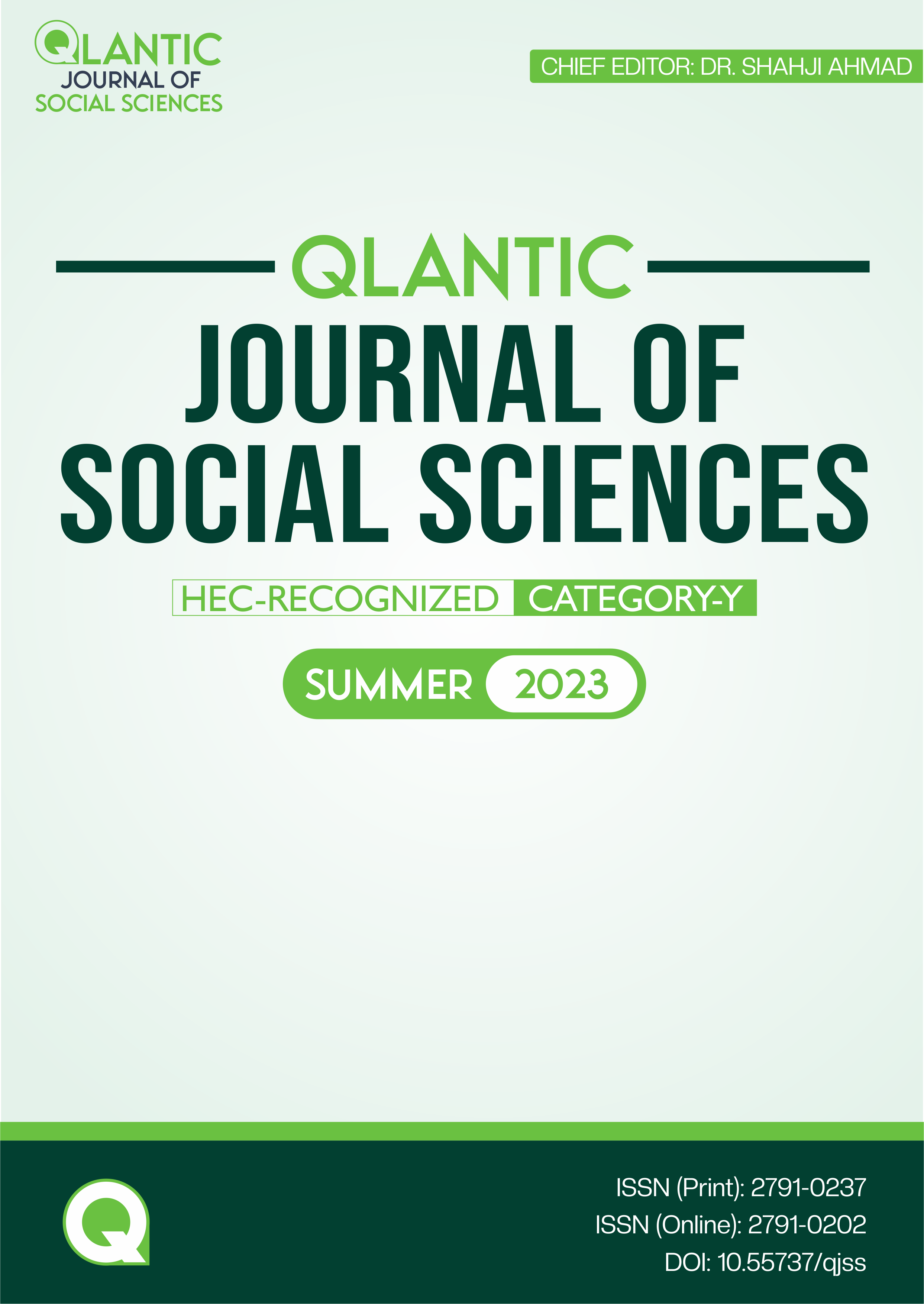Exploring the Portrayal of Indigenous Culture: A Sociocultural Critique of Folk Literature
DOI:
https://doi.org/10.55737/qjss.983954281Keywords:
Culture, Indigenous, Folk Literature, Truck Poetry, Language, Social InteractionAbstract
The current study examines the relation of culture and language, conveying a range of forms resulting in diversified meanings contextually. Enriched with a visual representation , Pakistani culture presented on vehicles such as trucks and public transport: buses, rickshaws and coasters are also the representation of the indigenization of the cultures through respective languages. The data has been collected from the truck pictures frequently shared on Instagram for the propagation of indigenous culture, language and business purposes to attract customers by putting those phrases and verses written on the rear view side of the trucks. A qualitative approach has been implied to evaluate the data, whereas, the nature of the study is analytical using the images. . The main objective of the study is to analyse the visualized and scripted poetry with reference to Hymes’ social interaction model of SPEAKING (1974) as a theoretical framework. The research suggests that the representation of folk literature on truck vehicles gives us glimpses of the public opinions such as political system, social injustice, economic injustices and more prevalent issues in the country.The findings of the study signifies that indigenous languages permeate the message through printed stuff on trucks.
References
Abrahams, R. D. (1993). Phantoms of romantic nationalism in Folkloristics. The Journal of American Folklore, 106(419), 3-37. https://doi.org/10.2307/541344
Ali, F. (2021). The Bold and the Beautiful: Portraiture in Pakistani Truck Art. Thesis. Georgia: Georgia State University. https://doi.org/10.57709/25963344
Basumatary, M. (2022) .A brief Study on Social functions and Aesthetic aspects of folk literature of Bodos. Addaiyan Journal of Arts, Humanities and Social Sciences. 4(8), 01-05. https://doi.org/10.36099/ajahss.4.8.1
Brunvand, J. H. (1978). The Study of American Folklore: An Introduction. Norton.
Campa, A. L. (1965). Folklore and history. Western Folklore, 24(1), 1. https://doi.org/10.2307/1498853
Carbaugh, D., & Boromisza‐Habashi, D. (2015). Ethnography of communication. The International Encyclopedia of Language and Social Interaction, 1-16. https://doi.org/10.1002/9781118611463.wbielsi119
Chandler, D. (2002). Semiotics: The Basics (1st ed). New York: Routledge
Elias, J. J. (2012). On Wings of Diesel: Trucks, Identity and Culture in Pakistan. Oxford: One World Publishers.
Emodi, L. (2011). A semantic analysis of the language of advertising. African Research Review, 5(4). https://doi.org/10.4314/afrrev.v5i4.69286
Gee, J. P. (2014). An Introduction to Discourse Analysis: Theory and Method. New York, USA: Routledge, Taylor, and Francis Group.
Gobo, G., & Marciniak, L. T. (2011). Ethnography. Qualitative research, 3(1), 15–36.
Goldreich, O., Juba, B., & Sudan, M. (2012). A theory of goal-oriented communication. Journal of the ACM, 59(2), 1–65. https://doi.org/10.1145/2160158.2160161
Hurford, J. R., Heasley, B., & Smith, M. B. (2007). Semantics: A coursebook. Cambridge University Press.
Hymes, D. (1974). Foundations of Sociolinguistics: An Ethnographic Approach: Philadelphia. University of Pennsylvania Press.
Kreidler. C. W. (1998). Introducing English Semantic. London: Routledge.
Leech, G. (2014). Language in literature: Style and Foregrounding. New York: Routledge.
Lefebvre, H. (2009). State, space, world: Selected essays. (N. Brenner & S. Elden, Eds; G. Moore, N. Brenner, & S. Elden, Trans.). Minneapolis: University of Minnesota Press.
Madan, A. (2018). Visual Semiotics of Truck Art in India: From Art on Trucks to a Digital Art Style. Dublin: Trinity College Dublin.
Ottenheimer, H. (2009). The Anthropology of Language: An Introduction to Linguistic Anthropology. Wadsworth Publishing: Wadsworth.
Schmid, A. (2000). Truck art as arena of contest. Journal of Social Sciences, 4(4), 235- 241. https://doi.org/10.1080/09718923.2000.11892273
Schulze, K. (2012). Mosques, palm trees and swords: religious symbolism in northern Nigerian lorry decorations. Annual Review of Islam in Africa, 11, 12-17. https://docplayer.net/41794542-Mosques-palm-trees-and-swords-religious-symbolism-in-northern-nigerian-lorry-decorations.html
Turner, G. (1992). British Cultural Studies: An Introduction. New York: Routledge.
Umezinwa, J. (2017). Analysis of a selected Bargain discourse using Dell Hymes Speaking Model. https://doi.org/10.13140/RG.2.2.21516.16004
Warren, D. M., Brokensha, D., & Slikkerveer, L. J. (Eds.). (1993). Indigenous knowledge systems: The cultural dimension of development. London: Kegan Paul.
Williams, K. C. (2000). Reproduced and emergent genres of communication on the World Wide Web. The Information Society, 16(3), 201-215. https://doi.org/10.1080/01972240050133652




